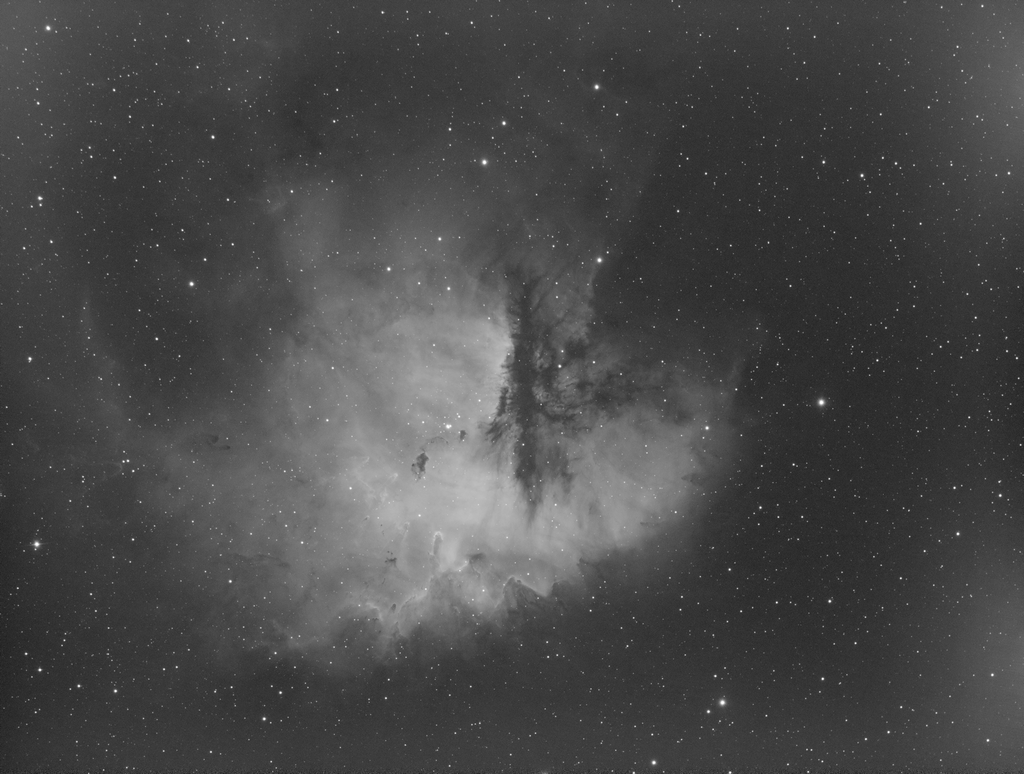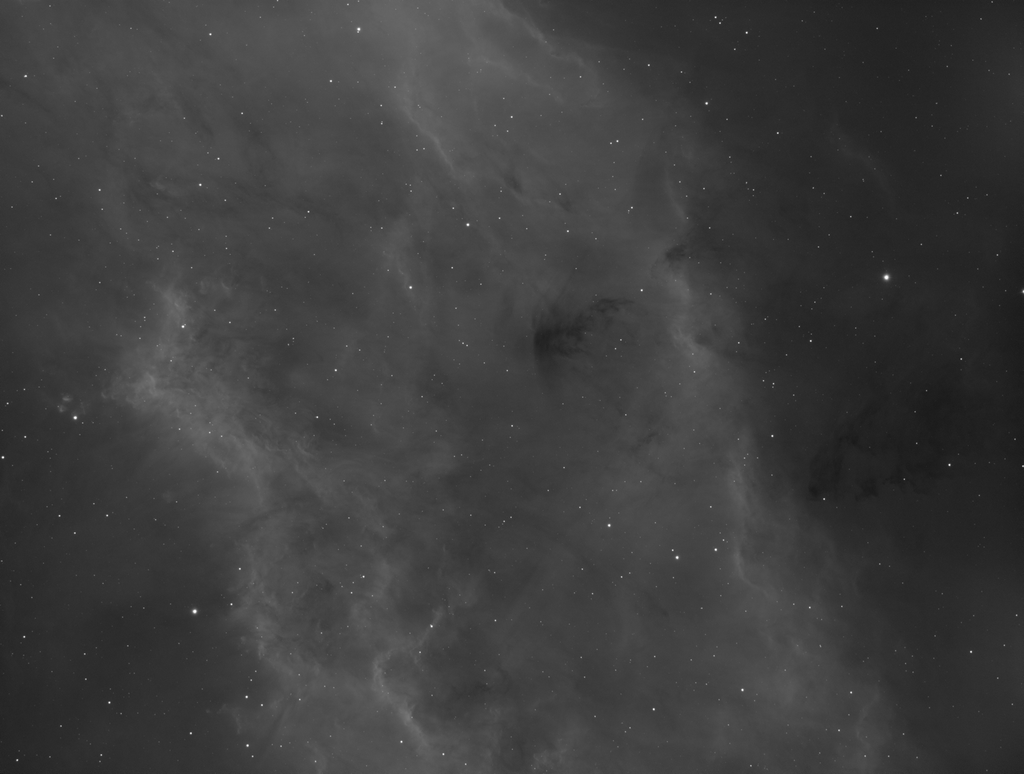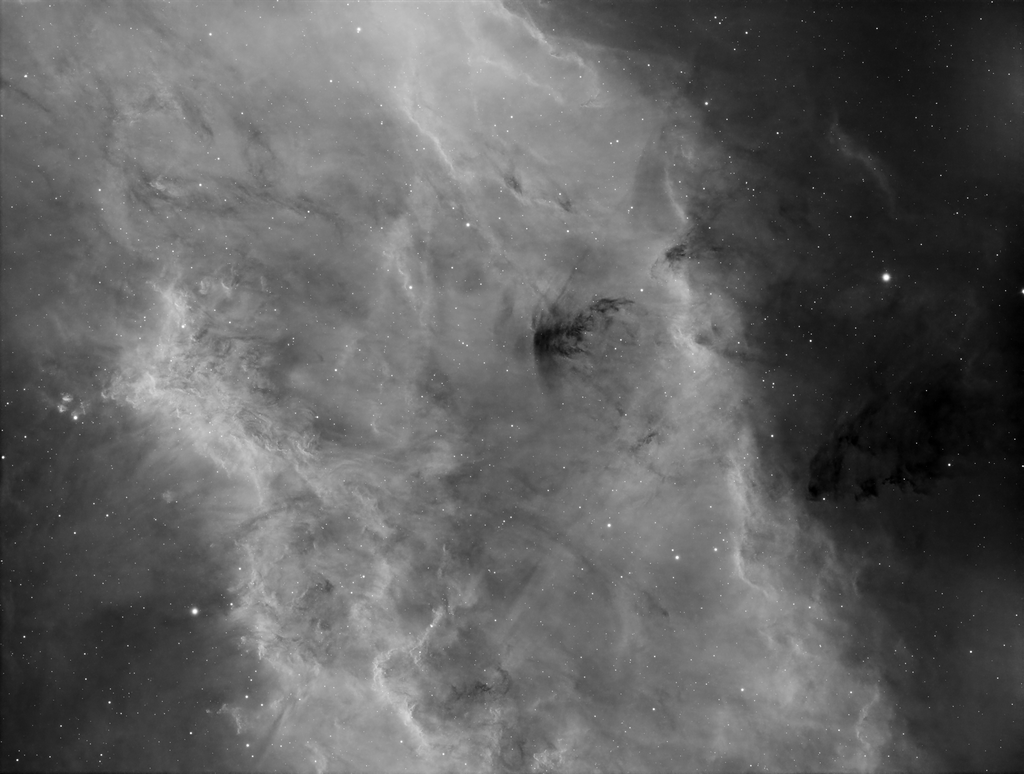Hi all, I recently purchased a 190MN and have so far been disappointed with its performance, although that could be be because I don't know how to collimate it properly. An example uncalibrated image is shown below. Much of the image shows distortion with the top left corner being the worst. I have tried several times using a Hotech laser collimator, but some part of the image (at least) always shows some sort of aberration. Apart from anything else I'm not very impressed with the stock focuser. There is obvious slop when replacing the collimator with the camera for example, but I don't know how serious that is.  One particular question I have is over what size field should we reasonably expect an aberration free image? My chip is an ASI 1600. Any advice on how to properly collimate, or tests to be run, would be very much appreciated. Thanks all!
|
You cannot like this item. Reason: "ANONYMOUS".
You cannot remove your like from this item.
Editing a post is only allowed within 24 hours after creating it.
You cannot Like this post because the topic is closed.
Copy the URL below to share a direct link to this post.
This post cannot be edited using the classic forums editor.
To edit this post, please enable the "New forums experience" in your settings.
Forget the laser, you can easily answer the collimation question by looking at a defocused star image at the center of the field. If the rings are concentric, you are collimated.
|
You cannot like this item. Reason: "ANONYMOUS".
You cannot remove your like from this item.
Editing a post is only allowed within 24 hours after creating it.
You cannot Like this post because the topic is closed.
Copy the URL below to share a direct link to this post.
This post cannot be edited using the classic forums editor.
To edit this post, please enable the "New forums experience" in your settings.
You might also consider an OCal. Epsilon users, including myself, have had very good luck with those. Instructions suck but you can find those online, including on Astrobin OCAL
|
You cannot like this item. Reason: "ANONYMOUS".
You cannot remove your like from this item.
Editing a post is only allowed within 24 hours after creating it.
You cannot Like this post because the topic is closed.
Copy the URL below to share a direct link to this post.
This post cannot be edited using the classic forums editor.
To edit this post, please enable the "New forums experience" in your settings.
I have the MN190, and it is trickier to collimate than a standard newtonian. In stead of springs pushing against the primary, there are two rubber rings on each collimation screw. It's a sign that the mirror cannot be pushed up into the tube. I use a cheshire and collimated laser for collimation. Be sure to NOT alter the position of the secondary down or up the tube. Only use the three collimation screws on the secondary. Use a cheshire to get the secondary correct. It should show the primary concentric. Then (I) use a laser to lign up the primary. Only small adjustments are allowed.
I agree that the focuser can be floppy. Several osers have replaced it by better ones. When you do, get a focuser that fits on the standard base plate.
cs,
Wim
|
You cannot like this item. Reason: "ANONYMOUS".
You cannot remove your like from this item.
Editing a post is only allowed within 24 hours after creating it.
You cannot Like this post because the topic is closed.
Copy the URL below to share a direct link to this post.
This post cannot be edited using the classic forums editor.
To edit this post, please enable the "New forums experience" in your settings.
I think what you are observing is just tilt of the image plane. The corrected field size diameter is around 28mm, if I recall the math right.
|
You cannot like this item. Reason: "ANONYMOUS".
You cannot remove your like from this item.
Editing a post is only allowed within 24 hours after creating it.
You cannot Like this post because the topic is closed.
Copy the URL below to share a direct link to this post.
This post cannot be edited using the classic forums editor.
To edit this post, please enable the "New forums experience" in your settings.
The stock focuser can be used if you push the extension tube all the way in and tighten the thumbscrews as much as possible (by hand). In the long run it’s better to swap it. I replaced mine with a Omegon steel track Crayford focuser, which does not have an extension tube. Any low profile focuser with a 78mm base should fit in the stock base plate. There should be old posts on this forum that cover this.
cs,
Wim
|
You cannot like this item. Reason: "ANONYMOUS".
You cannot remove your like from this item.
Editing a post is only allowed within 24 hours after creating it.
You cannot Like this post because the topic is closed.
Copy the URL below to share a direct link to this post.
This post cannot be edited using the classic forums editor.
To edit this post, please enable the "New forums experience" in your settings.
Thanks all for the helpful advice.
Tony, yes. I have done that to the best of my ability. It's the asymmetry across the field I'm struggling with.
Bill, yes, I'll look into getting one. Also the Cheshire Wim recommended.
Wim, thanks, all good advice. I'll follow your method once I get the Cheshire. By the way, if you own one of these, what is the point of the removable panel behind the primary? Is this to mount a cooling fan? My instrument came with no instructions of any kind.
Andrea, very helpful! I wanted someone to look at the image and suggest the most likely culprit for the asymmetry. I will work on adjusting the secondary to compensate.
|
You cannot like this item. Reason: "ANONYMOUS".
You cannot remove your like from this item.
Editing a post is only allowed within 24 hours after creating it.
You cannot Like this post because the topic is closed.
Copy the URL below to share a direct link to this post.
This post cannot be edited using the classic forums editor.
To edit this post, please enable the "New forums experience" in your settings.
By the way, if you own one of these, what is the point of the removable panel behind the primary? Is this to mount a cooling fan? Yes. There are holes for screws that fit a 90mm brushless fan, I believe. Otoh, a cooling fan can introduce vibrations. If you set up your mount every session, it would make sense to have a fan on before the session, so the scope cools down faster. But I would turn the fan off during exposures. Also, if you decide to install a fan, add a filter. Otherwise you'll be sucking dust into the tube. Btw, this thread may be of interest https://www.iceinspace.com.au/forum/showthread.php?s=e0e283c39b33ccf68a50505b8d81e654&t=140193Wim
|
You cannot like this item. Reason: "ANONYMOUS".
You cannot remove your like from this item.
Editing a post is only allowed within 24 hours after creating it.
You cannot Like this post because the topic is closed.
Copy the URL below to share a direct link to this post.
This post cannot be edited using the classic forums editor.
To edit this post, please enable the "New forums experience" in your settings.
Thanks for your thoughts Wim and, yes, lots of helpful information in that thread!
Anyway, I have no immediate plans to change the focuser. If I can correct the tilt (which I think is the problem) using the secondary, it will probably be fine as it is.
|
You cannot like this item. Reason: "ANONYMOUS".
You cannot remove your like from this item.
Editing a post is only allowed within 24 hours after creating it.
You cannot Like this post because the topic is closed.
Copy the URL below to share a direct link to this post.
This post cannot be edited using the classic forums editor.
To edit this post, please enable the "New forums experience" in your settings.
Thanks for your thoughts Wim and, yes, lots of helpful information in that thread!
Anyway, I have no immediate plans to change the focuser. If I can correct the tilt (which I think is the problem) using the secondary, it will probably be fine as it is. Hello- I too just took ownership of a new 190MN. Optics are great, once you figure out collimation. I contacted SW Support and they sent me a copy of the manual that came with Orion version of the scope - apparently no one at SW has bothered to write a manual for one of their more expensive scopes....go figure. It explains the collimation process and mechanics CLEARLY. It is quite different from collimating a newt and I am sure some users have screwed up their scopes doing things the shouldn't, like moving the secondary position up or down the tube. Ok, optically its fantastic. My first image was of the Perseus Double Cluster. The shape and color of the stars was better than any scope I have owned - small refractors, 8-13" newts, 8" cats, etc. IMO, its on par with large semi-premium APO refractors, but I am sure owners of WO and Stellarvue scopes in the 5-7" range would take issue with that statement. The Bad - the focuser is trash. It reminds me of a cheep department store telescope focuser. The focusers on their Quattro scopes are far better, but I'm not a fan of those for heavy imaging trains either. I just dont get why they chose this focuser to put on a scope they market as an "imaging powerhouse." I have been forced to use a one-shot color camera b/c it won't support a mono setup with OAG and filter wheel without introducing a massive amount of tilt and thus throwing off that collimation you worked so hard to achieve. I just got delivery of Moonlite focuser. No motor (I will use a ZWO EAF), a rotating collar for framing. The tube is 68mm diameter, so I got a 68mm to 48mm adapter that threads into the drawtube and into the imaging train - no thumbscrews or compression rings holding things together. I plan to get it installed and tested in the coming days. My hope and expectation is that this will be the final puzzle piece that makes this a "premium" imaging solution (at least for my budget).
|
You cannot like this item. Reason: "ANONYMOUS".
You cannot remove your like from this item.
Editing a post is only allowed within 24 hours after creating it.
You cannot Like this post because the topic is closed.
Copy the URL below to share a direct link to this post.
This post cannot be edited using the classic forums editor.
To edit this post, please enable the "New forums experience" in your settings.
Fellow MN190 owner:
Good advice already given and as stated by Andrea also, your problem is caused by tilt, not mis-collimation. The culprit is the single bolt against the brass ring, tilting the camera when fastening it. You will continue to struggle with this no matter what. As Wim stated, the quick fix is a better focuser. I will do that in time but for now I get great results with the ZWO tilter.
To try and answer your original question around corrected field: on paper the correction is not perfect to the edge, delivering around 30% the coma of an uncorrected Newtonian. You should get round stars on the 1600 chip in my view, as well as the 294. On APS-C like the 2600 you should start to see some deterioration in the corners, although I have seen narrow band images with round stars even into the corners on an 2600 camera.
I have also found that the non-round stars were much more pronounced in my Nikon D5300 with 3.91um pixels compared to the Canon 40D with its 5.71um pixels. The resolution will show the flaws more. I have seen many perfect raw images from 1600 and 533 chips on this scope. Try to measure the tilt with Astap or Siril and see if you can eliminate it somehow. Your corners will improve drastically.
In closing, you are not going to get the classic Newtonian collimation image with the MN190. You also do not collimate similarly as you need to keep the primary and meniscus optical axis aligned. For this reason, the Ocal type solutions will not work to achieve focus. They may help to see things better but your procedure to collimate will not be to get three concentric circles, only two.
|
You cannot like this item. Reason: "ANONYMOUS".
You cannot remove your like from this item.
Editing a post is only allowed within 24 hours after creating it.
You cannot Like this post because the topic is closed.
Copy the URL below to share a direct link to this post.
This post cannot be edited using the classic forums editor.
To edit this post, please enable the "New forums experience" in your settings.
Matt, thank you. Very helpful. I have had the same thoughts and experience. The poor quality focuser seems to completely defeat the point of this design. I'd happily pay a few hundred dollars extra (on top of the $2k) to avoid all of this unnecessary frustration. Also, as you say, their other scopes are better from that point of view. I own a couple of S-W designs and they are essentially perfect given their price point. And no instructions?? But, otherwise, yes the optics seem great. I would be interested to hear if your solution has worked. In the meantime I have been experimenting with a ZWO tilter per Coenie's suggestion. Coenie, thanks so much for the additional info. Also for letting me know about tilters. I had no idea they even existed. Was able to buy one and have been experimenting. I think I'm making progress but this sill requires a lot of patience. You can please take a look at an early iteration below. I think it is an improvement over the first image I posted (the intelligent thing would have been to do the same target, but of course I forgot to do that). Still has problems but hopefully I'm getting closer. I only hope that the tilt does not have to be adjusted depending on the orientation of the scope, etc. If not, then I think I'll be ok with this solution. One thing which doesn't help is that I've also recently started to use the ASIAIR. It is very good for some things but not so convenient for online feedback and measurements. I assume to run the software you mention I'll have to dig out the laptop. Maybe I should do that and reduce the guesswork. Anyway thanks again both. Uncalibrated with a screen stretch:  I processed this image a little bit, BlurXTerminator being most relevant. That helps. Not sure if I should be satisfied at this point: carry on tinkering, or get back to actual imaging.  |
You cannot like this item. Reason: "ANONYMOUS".
You cannot remove your like from this item.
Editing a post is only allowed within 24 hours after creating it.
You cannot Like this post because the topic is closed.
Copy the URL below to share a direct link to this post.
This post cannot be edited using the classic forums editor.
To edit this post, please enable the "New forums experience" in your settings.
Your corners are corrected enough in my view. Your processed image shows this. With tools like BlurX etc, you can correct that slight coma in the extreme corners if required. You seem to have cleared up the majority of it though. Although not ideal to run a single processed image through ASTAP for the tilt measure, the above image shows tilt at 12% and mild. The x-axis is the culprit. Further small adjustments to the x-axis should completely clear up all corners to pinpoint stars in my view. The 1600 can deliver that with the MN190.
I would suggest that you start imaging until you find anomalies in your final images that you want to remove. You can then review and consider if it is achievable optically or not. If so, you can revisit the tilting or whatever the solution may be.
You should find that when you do long sessions on an image where there are tracking movement in the final image, you end up cropping away the slight imperfections in the corners in any event. I would say with the standard focuser, if you can achieve 80+% of the ideal, just image as much as possible. That 20% balance will not return the results you think they would. You will end up chasing it and not image nearly enough.
That is unless you get a Moonlight, Steeltrack or Feathertouch focuser. Then you can chase the 20%, as achieving it will probably remain in place for much longer than with the standard focuser. Until then, I think you are good to go, to get some nice images from this great scope.
Clear skies!
|
You cannot like this item. Reason: "ANONYMOUS".
You cannot remove your like from this item.
Editing a post is only allowed within 24 hours after creating it.
You cannot Like this post because the topic is closed.
Copy the URL below to share a direct link to this post.
This post cannot be edited using the classic forums editor.
To edit this post, please enable the "New forums experience" in your settings.





